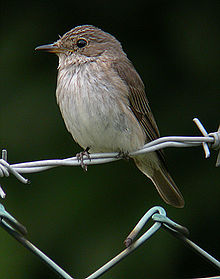- Spotted Flycatcher
-
Spotted Flycatcher 
Conservation status Scientific classification Kingdom: Animalia Phylum: Chordata Class: Aves Order: Passeriformes Family: Muscicapidae Genus: Muscicapa Species: M. striata Binomial name Muscicapa striata
(Pallas, 1764)The Spotted Flycatcher, Muscicapa striata, is a small passerine bird in the Old World flycatcher family. It breeds in most of Europe and western Asia, and is migratory, wintering in Africa and south western Asia. It is declining in parts of its range.
This is an undistinguished looking bird with long wings and tail. The adults have grey-brown upperparts and whitish underparts, with some streaking on the breast. The legs are short and black, and the bill is black and has the broad but pointed shape typical of aerial insectivores. Juveniles are browner than adults and show the spots on the upperparts which give this species its name.
Spotted Flycatchers hunt from conspicuous perches, making sallies after passing flying insects, and often returning to the same perch. Their upright posture is characteristic.
They are birds of deciduous woodlands, parks and gardens, with a preference for open areas amongst trees. They build an open nest in a suitable recess, often against a wall, and will readily adapt to an open-fronted nest box. 4-6 eggs are laid.
Interestingly, most European birds cannot discriminate between their own eggs and those of other species. The exception to this are the hosts of the Common Cuckoo, which have had to evolve this skill as a protection against that nest parasite. Spotted Flycatcher shows excellent egg recognition, and it is likely that it was once a host of the Cuckoo, but became so good at recognising the intruder's eggs that it ceased to be victimised.[2] A contrast to this is the Dunnock, which appears to be a recent Cuckoo host, since it does not show any egg discrimination.
Spotted flycatchers exhibit an atypical molt strategy, that is they molt their primaries and some of their secondaries in the reverse order from what is seen in most passerines. [3]
The flycatcher's call is a thin, drawn out soft and high pitched tssssseeeeeppppp, slightly descending in pitch.
Contents
References
- ^ BirdLife International (2004). Muscicapa striata. 2006. IUCN Red List of Threatened Species. IUCN 2006. www.iucnredlist.org. Retrieved on 12 May 2006. Database entry includes justification for why this species is of least concern
- ^ N.B. Davies, M. de L. Brooke (01 Feb 1989). "An Experimental Study of Co-Evolution Between the Cuckoo, Cuculus canorus, and its Hosts. I. Host Egg Discriminatione". Journal of Animal Ecology 58: 207–224. http://www.jstor.org/pss/4995.
- ^ Jenni, Lukas; Raffael Winkler and Thomas Degen (1994). Moult and ageing of European passerines. London, San Diego: Academic Press. ISBN 012384150X 9780123841506.
Further reading
Identification
- Bradshaw, C., P. J. Jepson and N. J. Lindsey. (1991) Identification of brown flycatchers British Birds 84(12):527-542
- Alström, Per & Erik Hirschfeld (1991) Field identification of Brown, Siberian and Grey-streaked Flycatchers Birding World 4(8):271-278
External links
- Spotted Flycatcher videos, photos & sounds on the Internet Bird Collection
- Ageing and sexing (PDF) by Javier Blasco-Zumeta
Categories:- IUCN Red List least concern species
- Muscicapa
- Birds of Asia
- Birds of Pakistan
- Birds of Europe
- Birds of Turkey
- Birds of Lithuania
Wikimedia Foundation. 2010.


